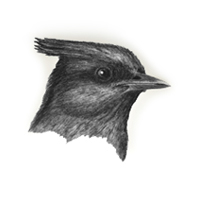|
Field
Guide IDs: BREEDING:
Coniferous and
mixed coniferous-deciduous forest, arid pine-oak
woodland. 1 brood. DISPLAYS:
Courtship feeding
of female by male; male circles female, aligns
sideways to her, often reversing direction through
180" jump. NEST:
On horizontal
branch or in crotch, occ in deciduous tree, shrub;
bulky foundation of twigs, dry leaves, cemented
with mud, lined with rootlets, pine needles,
grass. EGGS:
Pale greenish-blue
or bluish-green, marked with dark browns. 1.2" (30
mm). DIET:
30% insects, other
invertebrates and small vertebrates, bird eggs,
nestlings; 70% acorns or pine seeds, fruit, seeds.
December-January diet 90%-99% acorns or pine
seeds. CONSERVATION:
Winter resident;
some movement to lower elevations in
winter. NOTES:
Pair defend
territory of immediate vicinity around nest. Often
congregate at feeding sites, even when breeding.
Cache food and steal from Acorn Woodpecker caches.
Postbreeding family groups remain together until
fall. Scream strongly resembles Red-tailed Hawk's.
Hybridizes with Blue Jay where their ranges contact
along the Front Range of Colorado. Fairly rare
resident in wooded areas near the Dish, very rarely
occurring elsewhere on campus during
winter. ESSAYS: Hoarding
Food;
Great
Plains Hybrids;
Vocal
Copying;
Finding
Hidden Caches;
Courtship
Feeding;
DDT
and Birds. REFERENCES:
Brown, 1964;
Goodwin, 1976. |
